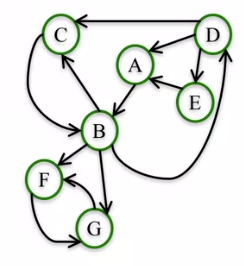01. Degree and Closeness Centrality
Node Importance
Different ways of thinking about "importance".
- Degree: number of friends
- Average proximity to other nodes.
- Fraction of shortest paths that pass through node.
Network Centrality
Centrality measures identify the most important nodes in a network.
Centrality Measures
- Degree centrality
- Closeness centrality
- Betweenness centrality
- Load centrality
- Page Rank
- Katz centrality
- Percolation centrality
Degree Centrality
Assumption: important nodes have many connections.
The most basic measure of centrality: number of neighbors.
Undirected Networks
, where N is the set of nodes in the network and dv is the degree of node v.
nx.degree_centrality(G)Directed Networks
nx.in_degree_centrality(G)nx.out_degree_centrality(G)Closeness Centrality
Assumption: important nodes are close to other nodes.
nx.closeness_centrality(G)Disconnected Nodes
If a node can't reach all other nodes:
Option 1: Consider only nodes that L can reach
Option 2: Consider only nodes that L can reach and normalize by the fraction of nodes L can reach:
nx.closeness_centrality(G, normalized=False)
nx.closeness_centrality(G, normalized=True) # default: normalized=True02. Betweenness Centrality
Assumption
Important nodes connect other nodes.
Endpoints: we can either include or exclude node v as node s and t in the computation of
- include node v
- exclude node v
Disconnected Nodes: we only consider node s, t such that there is at least one path between them.
Normalization
Betweenness centrality values will be larger in graphs with many nodes.
To control for this, we divide centrality values by the number of pairs of nodes in the graph (excluding v):
in undirected graphs
in directed graphs
Between two nodes, them can probably have two differently directed path.
# default: normalized=True, endpoints=False
nx.betweenness_centrality(G, normalized=True, endpoints=False)Approximation
Complexity: Depending on the algorithm, this computation can take up to
Approximation: rather than computing betweenness centrality based on all pairs of nodes s, t, we can approximate it based on a sample of nodes.
nx.betweenness_centrality(G, normalized=True, endpoints=False, k=10)Subsets
To find out what are the most important nodes in this network between a group of source nodes and a group of target nodes.
nx.betweenness_centrality_subset(G, [34, 33, 21], [1, 4, 13, 11])Edge Betweenness Centrality
To find important edges instead of nodes:
nx.edge_betweenness_centrality(G, normalized=True)
nx.edge_betweenness_centrality_subset(G, [34, 33, 21], [1, 4, 13, 11], normalized=True)03. Basic Page Rank
Developed by Google founders to measure the importance of webpages from the hyperlink network structure.
PageRank assigns a score of importance to each node. Important nodes are those with many in-link from important pages.
PageRank is mainly useful for directed networks.
Steps of Basic PageRank
n = number of nodes in the network
k = number of steps
- All nodes start with PageRank of 1/n.
- Perform the Basic PageRank Update Rule k times.
Basic PageRank Update Rule
Each node gives an equal share of its current PageRank to all the nodes it links to.
The new PageRank of each node is the sum of all the PageRank it received from other nodes.
For most networks PageRank Values converge as k get larger (k -> ∞)
04. Scaled Page Rank
Interpreting PageRank
The PageRank of a node at step k is the probability that a random walker lands on the node after taking k steps.
Random walk of k steps:
- Start on a random node.
- Then choose an outgoing edge at random and follow it to the next node. Repeat k times.
PageRank Problem
In some networks, a few nodes can "stuck up" all the PageRank from the network.

Random walk of k steps with damping parameter α:
Start on a random node.
Then:
- With probability α: choose an outgoing edge at random and follow it to the next node.
- With probability 1 - α: choose a node at random and go to it.
Repeat k times.
Scaled PageRank
The Scaled PageRank of k steps and damping factor α of a node n is the probability that a random walk with damping factor α lands on a n after k steps.
For most networks, as k gets larger, Scaled PageRank converges to a unique value, which depends on α.
Typically we use α between 0.8 and 0.9.
Damping factor works better in very large networks like the web or large social networks.
nx.pagerank(G, alpha=0.8)